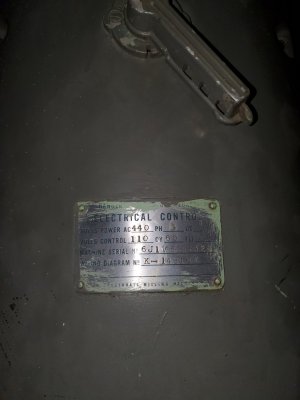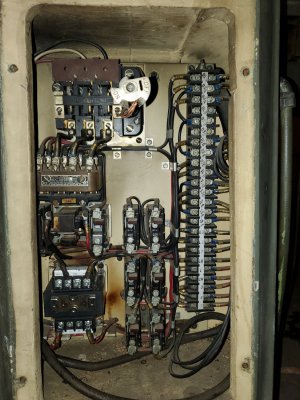- Joined
- Feb 4, 2021
- Messages
- 42
With that many separate motors (envious) you're best option my well be an RPC. Then you can use all of the machines original controls, only losing the variable speed of the VFD.
For the VFD, on the wiring diagram ignore everything except for the five motors on the extreme right. Each motor has three lines xT1, xT2, xT3 where x equals the motor number. Now, in the electrical box in the back of the machine there is a long terminal strip on the right side. Each position is labeled. One side will go to the motors (on mine it's the right side), the other side goes to the contactors/controls. You need to disconnect the control side, then bring your VFD lines in and daisy-chain down the stack.
L1 -> 1T1 -> 2T1 -> 3T1.......
Same for L2 and L3 to the xT2 and xT3 positions.
Addendum. Look at the top left of the wiring diagram. That is a map of the physical layout inside the electric control box. The "Circuit Interuptor" at the top is the keyed switch at that is controlled by the access hatch lever. The outside lines come into this. You should then be able to bring the LL1-2&3 straight over to xT1-2&3. Done this way, the original power lead can be used for the VFD. Just don't open the hatch door while the vehicle is in motion.
Thanks Randy! I'll look at your wiring scheme and think it over. It would be nice to have a VFD on the motor since that toothed belt is such a pain, but then again a bit more work in wiring and not as plug & play. The circuit interrupter you mentioned has a stranded wire tied around that extended pole that the hatch connects to, on my machine. Maybe that's why the contactor was tripping.
There is nothing wrong with having two VFDs especially if you allready own One??? Millions of machines out there have 2 VFDs. Some have dozens. Much cheaper, power efficient, and space savings than a rotary phase converter in your situation.
You can wire current controls to actuate the VFD, little hard to suggest how here as there are so many ways, or you can use the face plate of the VFD to control the motors. But yes, as mentioned before, the motors themselves should be direct wired, NEVER through a drum switch.
You do NOT use a single VFD to run two motors unless they are equal size and very similar outputs, which I highly doubt your power feed motor is anywhere close to the spindle motor.
This is what I was wondering about. In my case, it would be 4 VFDs (spindle, the 2 X&Y feeds, and coolant). Though, maybe you're right actually. If one VFD can power both powerfeeds (they're both 1/4hp, same motor basically), then I could just forgo the coolant motor and use 2 VFDs.




